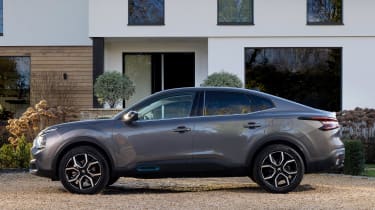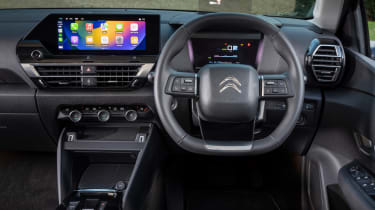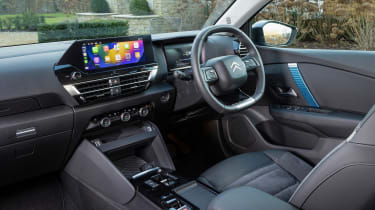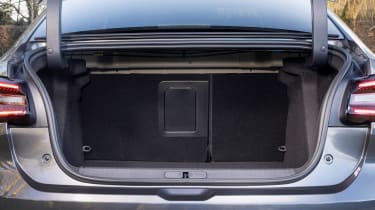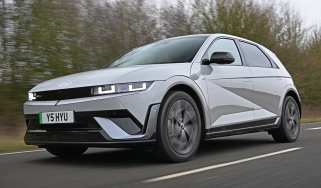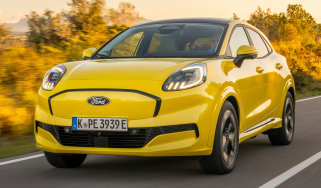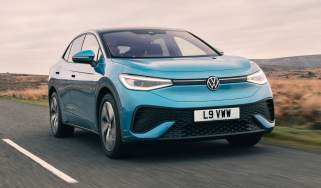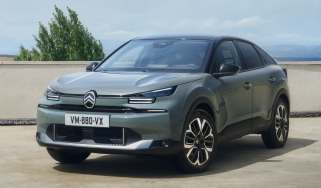Citroen e-C4 X review
“The Citroen e-C4 X is a refined and comfortable EV with a big boot, but its quirky body style might put off some buyers”
Pros
- Comfortable ride
- Large boot
- 100kW rapid charging
Cons
- Saloon-style boot lid
- Sluggish acceleration
- Mediocre driving range for 50kWh version
Verdict - Is the Citroen e-C4 X a good car?
The Citroen e-C4 X certainly isn’t without its appeal, but it won’t suit everyone. Its soft suspension and sedate acceleration make it a comfortable pick for tackling pothole-strewn roads and motorway trips, but don’t make for an engaging driving experience. Its elongated shape means it has a surprisingly large boot, but access is restricted by Citroen’s decision not to go with a hatchback design. Some cheaper EVs like the MG4 Long Range can also go considerably further on a charge.
Citroen e-C4 X range
Citroen describes its latest EV model as a fastback, but with the modern look of an SUV. Given its name, it would be easy to mistake the e-C4 X for just a slightly different version of the e-C4, but in fact, there are some quite big differences despite the fact they cost almost the same amount. The e-C4 X is 240mm longer, and because most of this extra bodywork is at the rear of the car, the boot has grown in size from 380 to 510 litres. Yet, Citroen has chosen a quirky raised saloon body style, so there’s a traditional boot lid instead of a hatchback.
The e-C4 X was originally released in the UK in solely electric guise, but as of May 2023, buyers will also be able to order its petrol and diesel equivalent, the C4 X, in the UK. This will help it appeal to a wider audience, in a similar fashion to its rival and Carbuyer Car of the Year for 2023 – the Kia Niro – which comes with a variety of different electric, hybrid and petrol engines. We haven’t yet driven the petrol or diesel versions of the C4 X, but these will be reviewed separately once we get behind the wheel.
More reviews
While it was originally available with a sole 134bhp electric motor option sending power to the front wheels and supplied by a 50kWh battery, May 2023 brought an update to the e-C4 X, ushering in a new 154bhp electric motor and 54kWh battery setup. The 50kWh battery version offers a range of up to 222 miles between charges, while the 54kWh version increases this to 260 miles. The Citroen can be topped-up at speeds of up to 100kW using public rapid charging. This can take it to 80% capacity in around 30 minutes.
The only real choice for the buyer is between the Sense, Shine, Shine Plus and new e-Series trim levels. Standard equipment is pretty generous, with features such as a 10-inch touchscreen with Apple CarPlay and Android Auto, while the range-topper gets adaptive cruise control, a head-up display and a heated steering wheel – features that Porsche Taycan buyers have to pay extra for.
|
Trim levels |
Power options |
|
|
Citroen e-C4 X alternatives
The Citroen e-C4 X might have a rather unique and quirky design, but it isn’t short of rivals that offer a raised seating position and all-electric powertrain. These include popular models from mainstream brands such as Peugeot, Renault and Kia, but there are also more luxurious choices if you want to head further upmarket.
Family electric SUVs
Premium electric SUVs
Coupe SUVs
Range, charging & running costs
At launch, the e-C4 X was only available with a 50kWh battery, providing a range of up to 222 miles on a single charge. To put this into context, that’s slightly further than the 206 miles the Peugeot e-2008 can manage with a similar battery, and three miles more than the Citroen e-C4 hatchback. Driving on a cool day (around five degrees celsius), the trip computer predicted a range of just over 200 miles from a full charge. Driving carefully we averaged 4 miles/kWh, and found that compared with earlier Citroen EV powertrains, it is noticeably more efficient at higher cruising speeds.
In May 2023, Citroen announced an update to the e-C4 X’s battery capacity options. Alongside the 50kWh battery setup, a newer 54kWh battery as used on the Vauxhall Astra Electric and Peugeot e-308 is now available, offering a longer 260-mile range on a charge. We’re yet to test it, but slightly shorter range figures are likely in real-world driving conditions.
For context, the MG4 Long Range is able to travel up to 281 miles between charges, despite the fact it undercuts the e-C4 X on price. The Kia Niro EV is even better, managing a 285-mile range figure, thanks to its excellent efficiency and larger battery, but it also costs more.
The Citroen does at least get competitive DC charging speeds of 100kW, so a 20% to 80% top-up should only take around 30 minutes at a compatible public charging station. This is actually quicker than the 77kW charging available in the Kia Niro EV, but the MG4 gets even faster 135kW charging as standard.
Like all electric cars, zero tailpipe emissions will help cut motoring costs for anyone moving from a petrol, diesel or hybrid model. VED (road tax) is free until 2025 and company-car drivers will benefit from the e-C4 X being in the lowest band for Benefit-in-Kind taxation. It can also enter low emissions zones, including the ULEZ in Central London for free.
If you’re not quite sure you want to go for the fully-electric e-C4 X, Citroen announced the C4 X will be available to order in the UK from May 2023 in petrol or diesel guise.
|
Model |
Range |
CO2 |
|
Single motor 134bhp |
222 miles |
0g/km |
| Single motor 154bhp | 260 miles | 0g/km |
Insurance
The Citroen e-C4 X sits in insurance group 21 for entry-level Sense models, with Shine and Shine Plus both in group 22 out of 50. Citroen hasn't revealed ratings for the newer e-Series models, though its higher price and sportier styling means it's likely to sit in the top of those two groups – or possibly even higher.
The MG4 will be even more costly to insure, starting in group 27 and increasing to group 29 for more powerful versions. The hybrid Renault Arkana E-Tech starts in group 15; on the whole, petrol-powered cars still boast lower insurance ratings.
Electric motor, drive & performance
With underpinnings shared with the e-C4 and only a small increase in weight, it’s no surprise that the e-C4 X drives in an almost identical manner. The focus is on comfort, so if you don’t see the point in your electric crossover being overly sporty and firm-feeling, the Citroen should hold appeal.
The use of Citroen’s innovative suspension that’s been designed to better soak up large bumps, means the e-C4 X can maintain its composure over crumbling tarmac and unavoidable potholes. Despite this, it doesn’t sway uncontrollably from side to side as you tackle a series of bends. This certainly makes it rather well suited to most British roads if your goal is simply arriving at your destination in unruffled comfort.
Its steering doesn’t provide much in the way of feedback about the road passing beneath you, but the amount of resistance as the car corners is about right, so it should be fine for most owners. Older Citroen’s were famed for offering a smooth and refined experience belying their size, and the e-C4 X should also be a pretty comfortable motorway companion.
Acceleration from the single electric motor is reasonably modest, but most buyers looking in this class should be content with the performance on offer. We also don’t have a complaint with the small delay between pressing the throttle pedal and the car accelerating. While some EVs zoom forward the instant you breathe on the accelerator, this isn’t always desirable for drivers predominantly switching from a combustion-engined car for the first time.
There’s also no denying some rivals offer more pace for the money. Despite being cheaper, the MG4 can sprint from 0-60mph in 7.7 seconds, while the Kia Niro EV offers similar levels of performance taking 7.8 seconds to hit 62mph from a standing start. With 134bhp, the Citroen e-C4 X takes 9.5 seconds to hit the same benchmark speed, and throttle response can be sharpened up slightly by engaging ‘Sport’ mode.
We’re yet to test the updated 154bhp model, but we’d expect this to accelerate a second quicker than the 134bhp model from 0-62mph, which is likely to feel like plentiful performance for a family crossover.
|
Model |
Power |
0-62mph |
Top speed |
|
Single electric motor |
134bhp |
9.7s |
93mph |
| Single electric motor | 154bhp | TBC | TBC |
Interior & comfort
The interior isn’t as quirky or interesting as many past Citroen models, including the fairly recent and now discontinued C4 Cactus. Instead, the dashboard is relatively conventional, with lots of horizontal surfaces, an infotainment touchscreen perched above the air vents in the centre console, and a digital instrument display for the driver. Shared with the e-C4, it’s logical and feels well laid out overall – even benefitting from some physical controls for the air-conditioning – but we’d prefer not to be able to see and touch quite so much hard plastic.
Its highlight is the front seats, which feature 15mm high-density foam pads to provide additional comfort. A similar material to a memory foam mattress, we felt just as fresh at the end of a two-hour drive as when we set off.
Infotainment and navigation
Citroen has never been a leader in infotainment, and while the setup in the e-C4 X moves things in the right direction, it’s still far from perfect. The 10-inch landscape touchscreen looks okay on Shine trim and above, but there’s no way to move the sat-nav map around with your fingers or pinch to zoom and look at your surroundings. The Sense trim also gets a 10-inch screen but it has a lower resolution, so doesn’t look as sharp. We’d almost certainly switch to using Apple CarPlay or Android Auto’s maps instead, and connectivity is included as standard. It’s also worth noting that the head-up display system added in Shine trim uses a small transparent piece of plastic sticking out of the dashboard, which works okay but isn’t quite as neat as windscreen projection.
We reckon one of the two entry trims will suit most buyers – with the Shine Plus and the new e-Series (available from June 2023) adding luxury features and sporty trim to the base and mid-spec cars. More information on what each version includes can be found below.
Key features | |
|
Sense
|
Shine (Sense plus…)
|
|
Shine Plus (Shine plus…)
|
e-Series (Shine plus…)
|
Practicality & boot space
The e-C4 X has a saloon-style boot lid, rather than a full hatchback, so the rear windscreen stays in position when it’s opened. This separates it from the e-C4, and most other SUV-style models with a hatchback design that many European buyers tend to prefer. The rear window itself is also rather small and high up, so you may find yourself looking at the clouds, rather than much of the traffic following behind.
While the passenger compartment hasn’t really grown in size, there does seem to be slightly more space in the back thanks to a more reclined rear seatback. The middle passenger won’t be very pleased with the slightly raised position, though, or the backrest which is home to a flip-down armrest, making it less comfortable for sitting in. Legroom is excellent, but headroom doesn’t feel as plentiful as in the hatchback version. Storage for odds and ends around the cabin is commendable, with 16 individual cubbies in total.
|
Size comparison | |||
|
Model |
Length |
Width |
Height |
|
Citroen e-C4 X |
4,600mm |
1,834mm |
1,525mm |
|
MG4 |
4,287mm |
1,836mm |
1,504mm |
|
Renault Megane E-Tech |
4,199mm |
1,768mm |
1,505mm |
|
Kia Niro EV |
4,420mm |
1,825mm |
1,570mm |
|
Skoda Enyaq iV Coupe |
4,653mm |
1,879mm |
1,621mm |
Boot space
The e-C4 X has been stretched in comparison with the e-C4, resulting in more space in the boot. Volume is now up from 380 litres to an impressive 510 litres, which is as much as you’d get in a large executive car and also beats the 464 litres up to the parcel shelf in the MG5 EV estate. The space is well-proportioned, and benefits from an extra cubby under the floor that’s easily able to swallow the charging cables.
The rear seat splits and folds in a conventional 40/60 ratio, but doesn’t create a very large opening. If you tend to carry large, bulky items like bicycles or furniture in the boot of your car, you may want to look elsewhere. This is exacerbated by the pronounced step in the boot floor when the seats are folded down.
|
Boot space comparison | |
|
Model |
Boot space |
|
Citroen e-C4 X |
510 litres |
|
MG4 |
363 litres |
|
Renault Megane E-Tech |
440 litres |
|
Kia Niro EV |
475 litres |
|
Skoda Enyaq iV Coupe |
570 litres |
Reliability & safety
While it’s too soon to make a verdict on the e-C4 X’s reliability, it’s reassuring to see Citroen itself climb from near the bottom of our Driver Power owner survey rankings in 2021 to a respectable 13th out of 29 carmakers in 2022.
A reasonably low 18.7% of owners reported a fault in the first 12 months, which is better than Skoda (21.6%), Kia (20.4%) or Renault‘s (22.5%) showing. Owners told us comfort was amongst the best of any brand, along with interior quality.
Safety
The e-C4 X is equipped with an impressive amount of standard safety equipment. Sense trims get autonomous emergency braking (AEB), speed limit information, lane-keeping assist, lane departure alerts and driver attention monitoring. Upgrading to Shine brings Safety Pack Plus, adding radar technology to the AEB for cyclist and nighttime detection, along with enhanced traffic sign recognition. All this might not be enough to secure a five-star Euro NCAP crash-test rating, however, because the Citroen e-C4 shares most of its technology with only managed four stars when it was tested.
Which Is Best?
Cheapest
- Name100kW Plus Standard Range 50kWh 5dr Auto
- Gearbox typeAuto
- RRP£27,710
Most Economical
- Name100kW Plus Standard Range 50kWh 5dr Auto
- Gearbox typeAuto
- RRP£27,710
Fastest
- Name115kW Max Extended Range 54kWh 5dr Auto
- Gearbox typeAuto
- RRP£30,500


